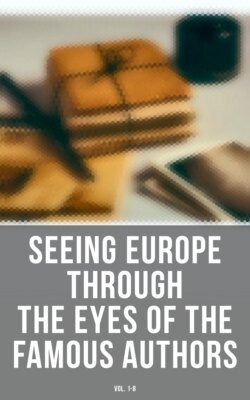Читать книгу Seeing Europe through the Eyes of the Famous Authors (Vol. 1-8) - Генри Джеймс - Страница 71
На сайте Литреса книга снята с продажи.
HOLYROOD1 By David Masson
ОглавлениеTable of Contents
Mary, Queen of Scots, on her return to Scotland after her thirteen years of residence and education in France, had to form her first real acquaintance with her native shores and the capital of her realm. She had left Calais for the homeward voyage on Thursday, the 14th of August, with a retinue of about one hundred and twenty persons, French and Scottish, embarked in two French state galleys, attended by several transports. They were a goodly company, with rich and splendid baggage. The Queen's two most important uncles, indeed—the great Francis de Lorraine, Duke of Guise, and his brother, Charles de Lorraine, the Cardinal—were not on board. They, with the Duchess of Guise, and other senior lords and ladies of the French court, had bidden Mary farewell at Calais, after having accompanied her thither from Paris, and after the Cardinal had in vain tried to persuade her not to take her costly collection of pearls and other jewels with her, but to leave them in his keeping till it should be seen how she might fare among her Scottish subjects.
But on board the Queen's own galley were three others of Guise or Lorraine uncles—the Duc d'Aumale, the Grand Prior, and the Marquis d'Elbeuf—with M. Danville, son of the Constable of France, and a number of French gentlemen of lower rank, among whom one notes especially young Pierre de Bourdeilles, better known afterward in literary history as Sieur de Brantôme, and a sprightly and poetic youth from Dauphiné, named Chastelard, one of the attendants of M. Danville. With these were mixed the Scottish contingent of the Queen's train, her four famous "Marys" included—Mary Fleming, Mary Livingstone, Mary Seton, and Mary Beaton. They had been her playfellows and little maids of honor long ago, in her Scottish childhood; they had accompanied her when she went abroad, and had lived with her ever since in France; and they were now returning with her, Scoto-French women like herself, and all of about her own age, to share her new fortunes. …
Then, as now, the buildings that went by the general name of Holyrood were distinguishable into two portions. There was the Abbey, now represented only by the beautiful and spacious fragment of ruin called the Royal Chapel, but then, despite the spoliations to which it had been subjected by recent English invasions, still tolerably preserved in its integrity as the famous edifice, in early Norman style, which had been founded in the twelfth century by David I., and had been enlarged in the fifteenth by additions in the later and more florid Gothic. Close by this was Holyrood House, or the Palace proper, built in the earlier part of the sixteenth century, and chiefly by James IV., to form a distinct royal dwelling, and so supersede that occasional accommodation in the Abbey itself which had sufficed for Scottish sovereigns before Edinburgh was their habitual or capital residence.
One block of this original Holyrood House still remains in the two-turreted projection of the present Holyrood which adjoins the ruined relic of the Abbey, and which contains the rooms now specially shown as "Queen Mary's Apartments." But the present Holyrood, as a whole, is a construction of the reign of Charles II., and gives little idea of the Palace in which Mary took up her abode in 1561. The two-turreted projection on the left was not balanced then, as now, by a similar two-turreted projection on the right, with a façade of less height between, but was flanked on the right by a continued chateau-like frontage, of about the same height as the turreted projections, and at a uniform depth of recess from it, but independently garnished with towers and pinnacles. The main entrance into the Palace from the great outer courtyard was through this chateau-like flank, just about the spot where there is the entrance through the present middle façade; and this entrance led, like the present, into an inner court or quadrangle, built round on all the four sides.
That quadrangle of chateau, touching the Abbey to the back from its northeastern corner, and with the two-turreted projection to its front from its northwestern corner, constituted, indeed, the main bulk of the Palace. There were, however, extensive appurtenances of other buildings at the back or at the side farthest from the Abbey, forming minor inner courts, while part of that side of the great outer courtyard which faced the entrance was occupied by offices belonging to the Palace, and separating the courtyard from the adjacent purlieus of the town. For the grounds of both Palace and Abbey were encompassed by a wall, having gates at various points of its circuit, the principal and most strongly guarded of which was the Gothic porch admitting from the foot of the Canongate into the front courtyard. The grounds so enclosed were ample enough to contain gardens and spaces of plantation, besides the buildings and their courts. Altogether, what with the buildings themselves, what with the courts and gardens, and what with the natural grandeur of the site—a level of deep and wooded park, between the Calton heights and crags, on the one hand, and the towering shoulders of Arthur's Seat and precipitous escarpment of Salisbury Crags on the other—Holyrood in 1561 must have seemed, even to an eye the most satiated with palatial splendors abroad, a sufficiently impressive dwelling-place to be the metropolitan home of Scottish royalty.
1 From "Edinburgh Sketches and Memories."
